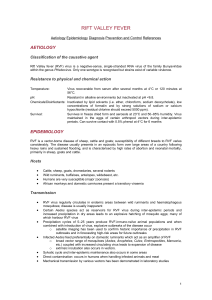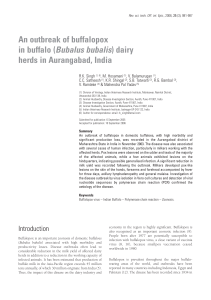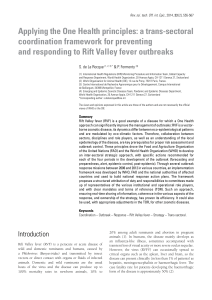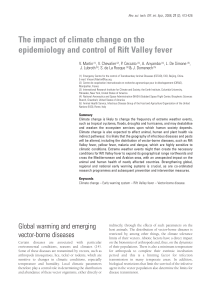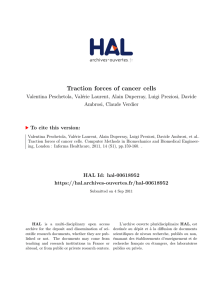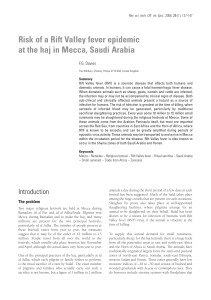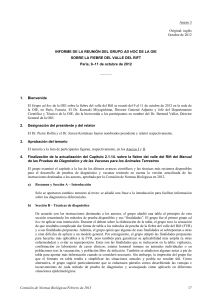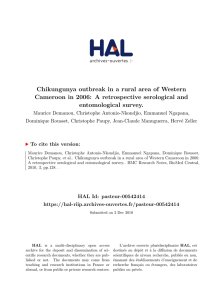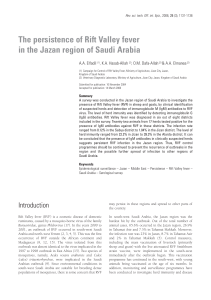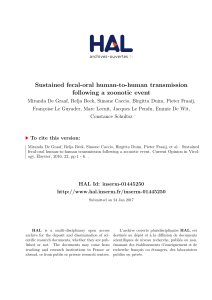D7603.PDF
publicité
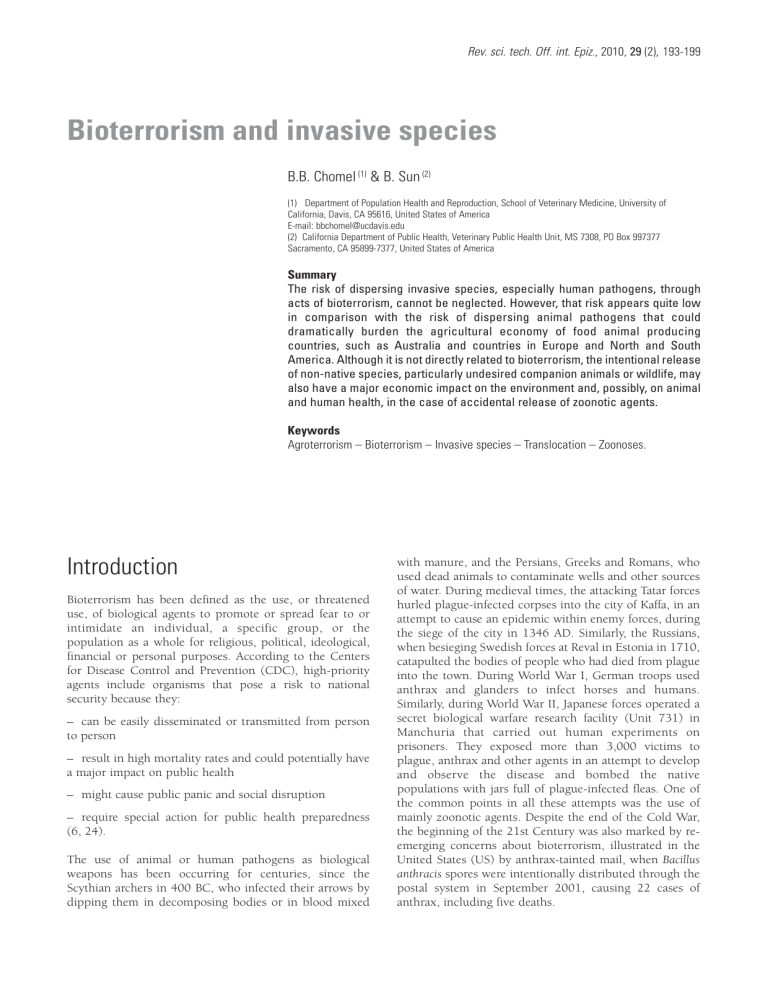
Rev. sci. tech. Off. int. Epiz., 2010, 29 (2), 193-199 Bioterrorism and invasive species B.B. Chomel (1) & B. Sun (2) (1) Department of Population Health and Reproduction, School of Veterinary Medicine, University of California, Davis, CA 95616, United States of America E-mail: [email protected] (2) California Department of Public Health, Veterinary Public Health Unit, MS 7308, PO Box 997377 Sacramento, CA 95899-7377, United States of America Summary The risk of dispersing invasive species, especially human pathogens, through acts of bioterrorism, cannot be neglected. However, that risk appears quite low in comparison with the risk of dispersing animal pathogens that could dramatically burden the agricultural economy of food animal producing countries, such as Australia and countries in Europe and North and South America. Although it is not directly related to bioterrorism, the intentional release of non-native species, particularly undesired companion animals or wildlife, may also have a major economic impact on the environment and, possibly, on animal and human health, in the case of accidental release of zoonotic agents. Keywords Agroterrorism – Bioterrorism – Invasive species – Translocation – Zoonoses. Introduction Bioterrorism has been defined as the use, or threatened use, of biological agents to promote or spread fear to or intimidate an individual, a specific group, or the population as a whole for religious, political, ideological, financial or personal purposes. According to the Centers for Disease Control and Prevention (CDC), high-priority agents include organisms that pose a risk to national security because they: – can be easily disseminated or transmitted from person to person – result in high mortality rates and could potentially have a major impact on public health – might cause public panic and social disruption – require special action for public health preparedness (6, 24). The use of animal or human pathogens as biological weapons has been occurring for centuries, since the Scythian archers in 400 BC, who infected their arrows by dipping them in decomposing bodies or in blood mixed with manure, and the Persians, Greeks and Romans, who used dead animals to contaminate wells and other sources of water. During medieval times, the attacking Tatar forces hurled plague-infected corpses into the city of Kaffa, in an attempt to cause an epidemic within enemy forces, during the siege of the city in 1346 AD. Similarly, the Russians, when besieging Swedish forces at Reval in Estonia in 1710, catapulted the bodies of people who had died from plague into the town. During World War I, German troops used anthrax and glanders to infect horses and humans. Similarly, during World War II, Japanese forces operated a secret biological warfare research facility (Unit 731) in Manchuria that carried out human experiments on prisoners. They exposed more than 3,000 victims to plague, anthrax and other agents in an attempt to develop and observe the disease and bombed the native populations with jars full of plague-infected fleas. One of the common points in all these attempts was the use of mainly zoonotic agents. Despite the end of the Cold War, the beginning of the 21st Century was also marked by reemerging concerns about bioterrorism, illustrated in the United States (US) by anthrax-tainted mail, when Bacillus anthracis spores were intentionally distributed through the postal system in September 2001, causing 22 cases of anthrax, including five deaths. 194 Bioterrorism, zoonoses and invasive species Among the various infectious agents classified as Class A bioterrorism agents by the CDC, all but one are zoonotic. A model of the impact of three classic agents of biological warfare (B. anthracis, Brucella melitensis and Francisella tularensis), when released as aerosols in the suburb of a major city, showed that the economic impact of a bioterrorist attack could range from US$477.7 million (brucellosis) to US$26.2 billion (anthrax) per 100,000 persons exposed (18). A distinction needs to be made between zoonotic pathogens that are absent from a region (such as Nipah virus or Rift Valley fever virus in Europe and the Americas) or have been eradicated (such as brucellosis in northern Europe) but could be intentionally re-introduced, and pathogens that are still endemic (tularemia or anthrax in many European countries and North America) and could be used as biological weapons by aerosolisation or the introduction of infected animals or produce. A few zoonotic agents are reviewed below, to illustrate the concept of invasive species. Anthrax As stated by Franz (12): ‘For the immediate future and because of its unique physical and biological characteristics and the publicity it received in 2001, we might postulate that use of Bacillus anthracis is more likely than a number of other microbial agents that could be used as weapons.’ As a result of its easy aerosolisation and wide dispersion by wind (as shown by an accident in Sverdlovsk in April 1979), the use of anthrax to infect humans and animals is always a risk (20), even in endemic areas where the disease usually causes a limited number of animal cases and, quite rarely, human cases. Brucellosis The airborne transmission of brucellosis occurs primarily among abattoir workers and presents the same symptoms as when this disease results from other routes of infection (26). Transmission by aerosols, especially of Brucella suis, confirms its potential as a possible biological weapon and in fact brucellosis was developed as such by the US in 1942. Although the offensive programme was terminated in 1969, and munitions were never used in combat, Brucella was formulated into bombs to maintain long-term viability and tested in the field. In recent years, interest in Rev. sci. tech. Off. int. Epiz., 29 (2) airborne Brucella has increased, in light of the emerging threat from terrorist attacks. Brucella is a CDC category B select agent, because it is considered moderately easy to disseminate, can cause moderate morbidity and low mortality and requires specific enhancements to the CDC diagnostic capacity and enhanced disease surveillance (26). The intentional release of Brucella-infected animals, especially wildlife, could also be a source of domestic animal reinfection and possible human infection, leading to major economic burdens, trade restrictions and costly eradication programmes. Plague In 1970, the World Health Organization (WHO) of the United Nations issued a comprehensive report on the potential use of biological weapons over populated areas. The report indicated that the deliberate release of 50 kg of Yersinia pestis in aerosolised form over a city of five million could cause as many as 150,000 cases of pneumonic plague. Some 36,000 people would probably die from the disease. In addition, plague bacilli would remain viable in the area for at least one hour, within a distance of 10 km (19). Of added concern was the possibility that people seeking to escape the scene would carry the bacilli with them, thereby causing even further spread, as probably occurred during the plague outbreak in Surat, India, in 1994. One-quarter of the residents of Surat (400,000 to 600,000 people) fled the city within four days of the announcement of the epidemic. Among them were people still in the incubation phase of the infection (25). Concern about the dispersal and persistence of the infection among urban or wildlife rodent reservoirs also needs to be taken into consideration. Rift Valley fever A number of laboratory workers have become infected with Rift Valley fever (RVF) virus, indicating that it can be readily transmitted by aerosol. A group of WHO consultants have estimated that, if 50 kg of RVF virus were released from an aircraft along a 2 km line upwind of a population centre of 500,000 people, 400 would die and 35,000 would be incapacitated (9). The virus is included by the Working Group on Civilian Biodefense (an expert panel convened by the Johns Hopkins Bloomberg School of Public Health) among those considered likely to be used as a biological weapon. The Working Group also cites the concern that, if RVF is used in such a manner, susceptible domestic livestock could become infected, resulting in the establishment of the disease in the environment (30). Tularemia Francisella tularensis is one of the most infectious pathogenic bacteria known, requiring inoculation or 195 Rev. sci. tech. Off. int. Epiz., 29 (2) inhalation of as few as 10 organisms to initiate human infection. If F. tularensis were used as a weapon, the bacteria would probably be made airborne for exposure by inhalation. People who inhaled an infectious aerosol would generally experience severe respiratory illness, including life-threatening pneumonia and systemic infection, if they were not treated. Another route of contamination in a deliberate release could be through water. Streptomycin and gentamicin are currently considered the treatment of choice for tularemia. No isolation measures for patients with pneumonia are necessary. Streptomycin, gentamicin, doxycycline or ciprofloxacin are recommended for post-exposure prophylaxis (4). The bacteria that cause tularemia occur widely in nature and could be isolated and grown in quantity in a laboratory, although manufacturing an effective aerosol weapon would require considerable sophistication (7). However, person-to-person transmission is uncommon and the dispersion of F. tularensis as a weapon would be unlikely to generate secondary cases or persist within the targeted population. Venezuelan equine encephalitis Venezuelan equine encephalitis (VEE) virus is more probable as a bio-warfare candidate than other equine encephalitis viruses (Western or Eastern), because of its lower human infectious dose (30). Significantly, VEE virus has caused at least 150 human laboratory infections, indicating the ease of aerosol transmission of the virus and resulting in a biosafety level 3 categorisation of the agent. Rabies To a lesser extent, rabies could be included among potential zoonotic bioterrorism agents, as intentional translocations may have multiple negative consequences, including the increased stress and mortality of relocated animals, negative impacts on resident animals at the release sites, increased conflicts with human interests, and the spread of disease (8). It could be the source of a major economic burden on human health, in terms of the immense costs of postexposure rabies treatments, vaccinating domestic animals (mainly companion animal carnivores), and controlling the outbreak within a highly susceptible population. Even though these were not acts of bioterrorism, the translocation of rabid raccoons (Procyon lotor) in the US in the late 1970s (8) and the release of non-native species, such as the raccoon dog (Nyctereutes procyonoides), in western Russia in the first half of the 20th Century, and consequent spread of the disease through eastern and north-eastern Europe (31), clearly illustrate the consequences that could result from such undesirable events. Agroterrorism and invasive species In the past 100 years, there have been approximately 12 events involving the intentional introduction of microbiological agents into livestock and animal populations around the world. Three of these events occurred during World War I in the US, when German agents introduced glanders and anthrax into horse and mule populations in Maryland, Virginia and New York, from 1915 to 1916 (32). Agriculture is one of the easiest sectors of the US economy to disrupt, and its disruption could have catastrophic consequences for the US and world economies (11). Agriculture in the US accounts for 13% of the current gross domestic product and provides employment for 17% of the population (24). It produces high-quality, cheap, plentiful food for domestic consumption and earns more than US$50 billion in exports. The likelihood of terrorist acts interrupting the production, processing and distribution of agricultural products is high. A number of different possible plant or animal pathogens could cause harm to or loss of production, and even an act of agroterrorism that did not result in the destruction of foodstuffs or interruptions in the food supply could have a psychological impact. Intentional disease attacks against agricultural commodities, especially livestock, would be economically devastating. Agricultural vulnerability, coupled with the ease of procuring, producing and disseminating animal pathogens, allows potential perpetrators to apply asymmetric tactics to significantly harm a nation that is increasingly immune to conventional attack (24). Bioterrorism acts are rare, despite their potentially devastating consequences; whereas biological invasions are occurring almost daily and are estimated to cost more than US$100 billion per year (21). It is estimated, for instance, that as many as 50,000 non-native species exist in the US (28). The ever-increasing international trade of goods and products favours the introduction of non-native organisms, such as the Asian tiger mosquito (Aedes albopictus), classified as one of the 100 worst invasive species in the world, according to the Global Invasive Species Database (14), and the dispersion of new zoonotic agents, such as chikungunya virus in the Indian Ocean islands (Réunion Island in 2005 to 2006) (17) and Italy in 2007 (1), or Dirofilaria immitis in dogs and cats. To produce an epidemic, pathogens must be easy to spread by aerosol, direct contact or flying insects beyond the initial site of attack. Only a handful of viruses fulfil these criteria: foot and mouth disease (FMD) in cattle and swine, rinderpest in cattle, classical and African swine fever in 196 pigs, avian influenza and Newcastle disease in birds and RVF virus (5). Foot and mouth disease The potential impact of intentionally introduced FMD on American livestock could be enormous, given that total sales in beef, pork and dairy products reach about US$74 billion annually (21). Foot and mouth disease virus is the most infectious virus known; it is some 20 times more infectious than smallpox and can survive for several months in the bone marrow of frozen carcasses (5). The 2001 outbreak in the United Kingdom was attributed to illegal meat imports and authorities spent six months struggling to control the outbreak, which cost about US $25 billion and ended with the slaughtering and destruction of some 11 million animals (5). With a highly concentrated and specialised industry (2% of the feedlots produce over 75% of the cattle; 75% of swine are in the Midwest), US livestock are an easy target (15). Approximately 3,000 truckloads of cattle per day are being moved in the US. Within eight days of an attack at a single location, as many as 23 million animals across 29 states may need to be destroyed (15). Therefore, modelling the possible consequences of such an attack is a major priority (2). African swine fever African swine fever is a devastating viral haemorrhagic disease of pigs. It causes major economic losses (a mortality rate of almost 100%), threatens food security and limits pig production in affected countries (10). There is no vaccine against ASF virus and this limits the options for disease control. African swine fever has been confined mainly to sub-Saharan Africa, where it is maintained in a sylvatic cycle and/or among domestic pigs. Wildlife hosts include wild pigs and arthropod vectors. The relatively small numbers of incursions onto other continents have proven to be very difficult to eradicate. Thus, ASF remained endemic in the Iberian Peninsula until the mid-1990s, following its introductions in 1957 and 1960, and the disease has remained endemic in Sardinia since its introduction in 1982. African swine fever has continued to spread within Africa to previously uninfected countries, including, recently, the Indian Ocean islands of Madagascar and Mauritius. Given the continued occurrence of ASF in sub-Saharan Africa, and increasing global movements of people and products, it is not surprising that further transcontinental transmission has occurred. The introduction of ASF into Georgia in the Caucasus in 2007, and dissemination to neighbouring countries, emphasises the global threat posed by ASF and further increases the risks to other countries (10). Rev. sci. tech. Off. int. Epiz., 29 (2) Rift Valley fever The intentional dispersion of RVF virus in a major ruminant breeding area, where vectors, such as mosquitoes, are abundant, could have a deleterious effect on the production (high mortality in young animals and abortion in females) and trade of farm animals. The principal public health impact of RVF is direct infection of humans. However, important secondary effects are likely to develop as an outbreak unfolds (3), including: – fears about food safety (especially meat products derived from livestock) – financial impacts on farmers – stigmatisation of infected individuals – distrust of scientific and medical authorities – harmful mental health effects among the general population. Similarly, veterinary and human medical resources will be severely strained in any outbreak. As stated by Bird et al. (3): ‘The potential impacts of RVF virus on North American and European agriculture and public health are considerable. Veterinarians in food animal practice will likely be the first medically trained professionals to encounter RVF virus in these regions because animals with clinical signs of RVF disease will likely be the first indication of virus introduction via natural processes or intentional acts of bioterrorism. The early recognition of an outbreak of a foreign animal disease by veterinary practitioners is a critical link in the control and eventual eradication of the disease. Only through a rapid and multidisciplinary response from entomologic and veterinary and human medical authorities can the potential spread of RVF virus be halted.’ Therefore, there is an immediate need for rapid disease detection and advanced diagnostic capabilities for foreign animal diseases to protect public health, animal agriculture and the numerous associated economies (16). Unintentional threats from the translocation and release of exotic animal species Natural threats are hazards introduced into a susceptible population, when the point of origin is unknown and there is no evidence of human intervention (13). They usually result from a biological invasion, such as the accidental introduction of West Nile virus into the US in 1999 or 197 Rev. sci. tech. Off. int. Epiz., 29 (2) avian influenza into Virginia in 2001. However, the release of unwanted exotic companion animals may be a source of disease dispersion, which was of major concern during the monkeypox outbreak which occurred in prairie dogs in the Midwestern states in 2003. The intentional release of nonnative species can have a major impact on the native population, as illustrated by the increase of the Burmese python (Python molurus bivittatus) population in the Everglades National Park in Florida. The number of pythons removed from the park increased from 2 in 2000 to 367 in 2009 (22). Nearly 112,000 of these animals have been imported into the US since 1990 and, in recent years, hundreds of the pythons have ended up in the Everglades National Park and surrounding areas (23). Anywhere between 20,000 and 150,000 pythons are now estimated to be on the loose there. While individual releases of unwanted companion animals contribute to the numbers, most are thought to be the descendants of baby pythons inadvertently freed when Hurricane Andrew devastated the region in 1992 (29). Prairie dogs (Cynomys spp.) are native to North America. They have proved to be a relatively popular companion animal in North America and in many countries around the world. All or the vast majority of prairie dogs that were sold in the companion animal trade were caught in the wild. Two zoonotic diseases that naturally occur in wild prairie dogs are tularemia and plague. Epizootics of both these diseases have occurred in recently captured prairie dogs intended for the companion animal trade. The prairie dogs with tularemia were widely distributed within the US and internationally before the disease was recognised (27). Following the monkeypox outbreak in 2003 in the US, the sale of prairie dogs as companion animals has been banned. Conclusion The risk of dispersing invasive species through acts of bioterrorism, especially human pathogens, cannot be neglected. However, that risk appears quite low in comparison with the risk of dispersing animal pathogens that could dramatically burden the agricultural economy of countries that produce food animals, such as Australia and countries in Europe and North and South America. Although it is not directly related to bioterrorism, the intentional release of non-native species, particularly undesired companion animals or wildlife, may also have a major economic impact on the environment and, possibly, on animal and human health in the case of accidental release of zoonotic agents. Bioterrorisme et espèces envahissantes B.B. Chomel & B. Sun Résumé Le risque de dissémination d’espèces envahissantes, et particulièrement d’agents pathogènes pour l’homme, suite à un acte de bioterrorisme ne doit pas être sous-estimé. Toutefois, sa probabilité paraît très faible comparée au risque de propagation d’agents pathogènes d’origine animale, qui sont susceptibles d’affecter de manière spectaculaire l’économie agricole des grands pays producteurs d’animaux destinés à la consommation humaine, comme l’Australie et les pays d’Europe et d’Amérique du Nord et du Sud. Sans être directement relié au bioterrorisme, le lâcher intentionnel d’espèces non autochtones, dont des espèces d’animaux de compagnie ou d’animaux sauvages nuisibles peut également avoir un impact important sur l’économie et l’environnement, voire sur la santé animale et publique dans les cas d’introductions accidentelles d’agents zoonotiques. Mots-clés Agroterrorisme – Bioterrorisme – Espèce envahissante – Transfert – Zoonose. 198 Rev. sci. tech. Off. int. Epiz., 29 (2) Bioterrorismo y especies invasoras B.B. Chomel & B. Sun Resumen La dispersión de especies invasoras, en especial de patógenos humanos, a consecuencia de un acto terrorista es un riesgo que no cabe ignorar. Sin embargo, esa amenaza no parece muy probable en comparación con el riesgo de diseminar patógenos animales capaces de imponer un duro tributo a la economía agrícola de los principales países productores de animales destinados al consumo humano, como Australia y los países europeos y de América del Norte y del Sur. Aunque no guarde relación directa con el terrorismo biológico, la liberación intencionada de especies no autóctonas, sobre todo de animales salvajes o de compañía no deseados, también puede ejercer profundos efectos sobre el medio ambiente y, seguramente, sobre la salud humana y animal en caso de liberación accidental de agentes zoonóticos. Palabras clave Agroterrorismo – Bioterrorismo – Especie invasora – Translocación – Zoonosis. References 1. Angelini P., Macini P., Finarelli A.C., Pol C., Venturelli C., Bellini R. & Dottori M. (2008). – Chikungunya epidemic outbreak in Emilia-Romagna (Italy) during summer 2007. Parassitologia (Rome), 50 (1-2), 97-98. 2. Bates T.W., Thurmond M.C. & Carpenter T.E. (2003). – Results of epidemic simulation modeling to evaluate strategies to control an outbreak of foot-and-mouth disease. Am. J. vet. Res., 64 (2), 205-210. 3. Bird B.H., Ksiazek T.G., Nichol S.T. & Maclachlan N.J. (2009). – Rift Valley fever virus. JAVMA, 234 (7), 883-893. 4. Bossi P., Tegnell A., Baka A., Van Loock F., Hendriks J., Werner A., Maidhof H. & Gouvras G; Taskforce on Bioterrorism (BICHAT), Public Health Directorate, European Commission, Luxembourg (2004). – BICHAT guidelines for the clinical management of tularaemia and bioterrorismrelated tularaemia. Eurosurveillance, 9 (12), E9-10. 5. Breeze R. (2004). – Agroterrorism: betting far more than the farm. Biosecur. Bioterror., 2 (4), 251-264. 6. Centers for Disease Control and Prevention (CDC) (2010). – Emergency preparedness and response: bioterrorism agents/diseases. CDC, Atlanta, Georgia. Available at: www.bt.cdc.gov/agent/agentlist-category.asp (accessed on 14 April 2010). 7. Centers for Disease Control and Prevention (CDC) (2010). – Emergency preparedness and response: key facts about tularemia. CDC, Atlanta, Georgia. Available at: www.bt. cdc.gov/agent/tularemia/facts.asp (accessed on 14 April 2010). 8. Chipman R., Slate D., Rupprecht C. & Mendoza M. (2008). – Downside risk of wildlife translocation. Dev. Biol. (Basel), 131, 223-232. 9. Christopher G.W., Cieslak T.J., Pavlin J.A. & Eitzen E.M. Jr (1997). – Biological warfare. A historical perspective. JAMA, 278 (5), 412-417. 10. Costard S., Wieland B., de Glanville W., Jori F., Rowlands R., Vosloo W., Roger F., Pfeiffer D.U. & Dixon L.K. (2009). – African swine fever: how can global spread be prevented? Philos. Trans. roy. Soc. Lond., B, biol. Sci., 364 (1530), 2683-2696. 11. Cupp O.S., Walker D.E. II & Hillison J. (2004). – Agroterrorism in the U.S.: key security challenge for the 21st century. Biosecur. Bioterror., 2 (2), 97-105. 12. Franz D.R. (2009). – Preparedness for an anthrax attack. Molec. Asp. Med., 30 (6), 503-510. E-pub.: 18 July 2009. Rev. sci. tech. Off. int. Epiz., 29 (2) 199 13. Gilpen J.L. Jr, Carabin H., Regens J.L. & Burden R.W. Jr (2009). – Agriculture emergencies: a primer for first responders. Biosecur. Bioterror., 7 (2), 187-198. 24. Noah D.L., Noah D.L. & Crowder H.R. (2002). – Biological terrorism against animals and humans: a brief review and primer for action. JAVMA, 221 (1), 40-43. 14. Global Invasive Species Database (2010). – 100 of the world’s worst invasive alien species. Available at: www.issg.org/ database/species/search.asp?st=100ss (accessed on 14 April 2010). 25. Pallipparambil G.R. (2010). – The Surat plague and its aftermath. In Insects, disease, and history. Available at: http://entomology.montana.edu/historybug/YersiniaEssays/ Godshen.htm (accessed on 27 April 2010). 15. Greger M. (2007). – The long haul: risks associated with livestock transport. Biosecur. Bioterror., 5 (4), 301-311. 26. Perkins S.D., Smither S.J. & Atkins H.S. (2010). – Towards a Brucella vaccine for humans. FEMS Microbiol. Rev., 34, 379-394. 16. Hietela S.K. & Ardans A.A. (2003). – Molecular weapons against agricultural vulnerability and the war on terror. J. vet. med. Educ., 30 (2), 155-156. 17. Josseran L., Paquet C., Zehgnoun A., Caillere N., Le Tertre A., Solet J.L. & Ledrans M. (2006). – Chikungunya disease outbreak, Reunion Island. Emerg. infect. Dis., 12 (12), 19941995. 27. Phalen D.N. (2004). – Prairie dogs: vectors and victims. Semin. avian exotic Pet Med., 13 (2), 105-107. 28. Pimentel D., Lach L., Zuniga R. & Morrison D. (2000). – Environmental and economic costs of non-indigenous species in the United States. BioScience, 50, 53-65. 18. Kaufmann A.F., Meltzer M.I. & Schmid G.P. (1997). – The economic impact of a bioterrorist attack: are prevention and postattack intervention programs justifiable? Emerg. infect. Dis., 3 (2), 83-94. 29. Sherwell P. (2009). – A plague of Burmese pythons in the Everglades. Daily Telegraph, 2 August. Available at: www.telegraph.co.uk/news/worldnews/northamerica/usa/ 5956739/A-plague-of-Burmese-pythons-in-theEverglades.html (accessed on 14 April 2010). 19. Ligon B.L. (2006). – Plague: a review of its history and potential as a biological weapon. Semin. paediatr. infect. Dis., 17 (3), 161-170. 30. Sidwell R.W. & Smee D.F. (2003). – Viruses of the Bunya- and Togaviridae families: potential as bioterrorism agents and means of control. Antiviral Res., 57 (1-2), 101-111. 20. Meselson M., Guillemin J., Hugh-Jones M., Langmuir A., Popova I., Shelokov A. & Yampolskaya O. (1994). – The Sverdlovsk anthrax outbreak of 1979. Science, 266 (5188), 1202-1208. 31. Singer A., Kauhala K., Holmala K. & Smith G.C. (2009). – Rabies in northeastern Europe – the threat from invasive raccoon dogs. J. Wildl. Dis., 45 (4), 1121-1137. 21. Meyerson L.A. & Reaser J.K. (2003). – Bioinvasions, bioterrorism, and biosecurity. Front. Ecol. Environ., 1 (6), 307-314. 22. National Park Service, United States Department of the Interior (2010). – Everglades National Park: Burmese Python: species profile. Available at: www.nps.gov/ever/naturescience/ burmesepython.htm (accessed on 14 April 2010). 23. National Park Service, United States Department of the Interior (2010). – Everglades National Park: South Florida Natural Resources Center fact sheets: natural resources management: Burmese pythons. Available at: www.nps.gov/ ever/naturescience/sfnrcfactsheets.htm (accessed on 14 April 2010). 32. Wilson T.M., Gregg D.A., King D.J., Noah D.L., Perkins L.E., Swayne D.E. & Inskeep W. II (2001). – Agroterrorism, biological crimes, and biowarfare targeting animal agriculture. The clinical, pathologic, diagnostic, and epidemiologic features of some important animal diseases. Clin. Lab. Med., 21 (3), 549-591.


